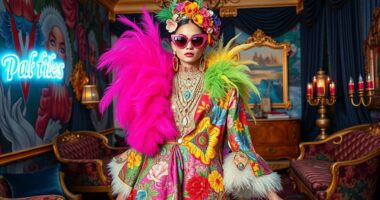Colors subtly influence your decisions by triggering emotions and perceptions deep in your mind. Bright reds can make you feel excited and prompt quick choices, while calming blues foster trust and reflection. Your personal and cultural experiences shape how you respond to hues, affecting your mood and behavior. Businesses use these insights to influence your perception and actions through strategic color choices. Keep exploring to uncover how understanding color psychology can help you make more conscious decisions.
Key Takeaways
- Colors evoke subconscious emotional responses that influence judgments and decision-making processes.
- Bright hues like red increase urgency and impulsivity, impacting choices in marketing and branding.
- Cool colors such as blue promote trust and calmness, shaping perceptions of reliability and safety.
- Cultural and personal experiences modify how individuals respond emotionally to different hues.
- Strategic color use in environments and products guides behavior and enhances desired decision outcomes.

Colors influence your emotions and perceptions in ways you might not even realize. When you see a shade, it doesn’t just sit there; it actively shapes how you feel and how you interpret your environment. This phenomenon is rooted in the psychology of color, which explores how different hues evoke specific emotional responses and influence decision-making. Your brain processes color perception quickly, often on a subconscious level, triggering reactions that can sway your choices without you realizing it. For example, bright reds can stimulate excitement and urgency, making you more likely to act quickly. On the other hand, calming blues tend to evoke feelings of trust and serenity, encouraging you to pause and reflect before deciding. These emotional responses are deeply ingrained and can vary depending on personal experiences, cultural background, and context.
Your perception of color influences your mood and behavior more than you might think. When you walk into a room painted in energetic orange, you may feel more enthusiastic and motivated, which can impact your productivity. Conversely, a muted or cool palette might make you feel relaxed or even a bit subdued. This connection between color perception and emotional response is why companies carefully select colors for branding, advertising, and product design. They want to elicit specific feelings that align with their message or brand identity. For instance, a financial institution might choose blue to convey stability and trustworthiness, while a fast-food chain might opt for red to stimulate appetite and excitement. Your responses to these colors are not random; they are shaped by a complex interplay of psychological and cultural factors.
Understanding how color influences decision-making can give you a strategic advantage in various aspects of life. When you’re designing a workspace, choosing the right colors can boost your focus or reduce stress. If you’re making a purchase, the color of the product can influence your perception of quality or value. Even in personal interactions, the colors you wear can affect how others perceive you and how they respond. Recognizing the power of color perception helps you become more aware of your environment and your emotional responses. This awareness allows you to use color intentionally, whether it’s to enhance your mood, improve productivity, or influence others. Fundamentally, the colors around you are not just aesthetic choices—they are tools that can subtly shape your decisions and emotional landscape every day.
Frequently Asked Questions
Can Color Preferences Vary Across Different Cultures?
You’ll find that color preferences definitely vary across cultures because of cultural symbolism and color taboo. For example, white signifies purity in some societies but mourning in others. You might notice that red is lucky in China, yet it can be a warning color elsewhere. These cultural differences influence how people perceive and choose colors, shaping preferences based on what certain hues represent and the taboos associated with them.
How Do Individual Experiences Affect Color Perception?
Think of your mind as a colorful tapestry, woven with personal memories and cultural symbolism. Your individual experiences shape how you perceive colors—what feels calming or energetic. A specific hue might remind you of a joyful childhood moment or carry cultural significance that influences your feelings. These personal memories make color perception unique to you, creating a rich, vibrant palette that colors how you interpret the world around you.
Are There Universal Color Associations Regardless of Context?
You might wonder if universal color associations exist beyond cultural symbolism. While some colors, like red for urgency or danger, are broadly recognized, many associations vary across cultures. In branding strategies, companies often leverage these common perceptions to connect with audiences worldwide. However, understanding local symbolism is vital, as it influences how your message is received, ensuring your branding resonates universally or locally as intended.
How Does Color Influence Subconscious Decision-Making?
Color influences your subconscious decision-making through color symbolism and subconscious triggers. When you see certain hues, your brain automatically associates them with specific feelings or meanings, guiding your choices without you realizing it. For example, red can evoke urgency or excitement, prompting quick actions, while blue might promote trust and calmness. These subconscious triggers shape your preferences and decisions, often without your awareness, leveraging the powerful impact of color on your mind.
Can Color Therapy Alter Emotional or Mental States?
Color therapy can indeed alter emotional or mental states by leveraging its effectiveness and emotional response triggers. When you engage with specific colors, you may experience calming, energizing, or mood-boosting effects. While scientific evidence varies, many find color therapy helpful for reducing stress or promoting relaxation. By consciously choosing colors during therapy sessions, you can activate emotional responses and potentially improve mental well-being over time.
Conclusion
As you step back and see the vibrant tapestry of colors around you, remember they’re more than just shades—they’re silent storytellers guiding your choices. Colors whisper secrets to your subconscious, shaping your feelings and decisions like a gentle tide pulling at your sails. So, next time you pick a hue, know you’re not just choosing a color, but dancing to its unseen melody—an invisible rhythm that stirs your mind and steers your heart.










